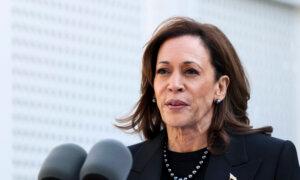The two presidential candidates agree that Americans are paying too much for drugs.
Despite accounting for over 17 percent of the United States’ GDP, health care access and affordability seem to receive limited attention during the 2024 presidential campaigns.
“For perhaps the first election season since 2004, health coverage policies have had a relatively low profile,” Sharon Glied, dean of New York University’s Robert F. Wagner Graduate School of Public Service, wrote in her opinion piece in the New England Journal of Medicine.
“The two biggest problems in health care: Millions of people can’t afford the care they need, and millions of people don’t have access to care they need. And neither candidate is addressing these two problems in any serious way,” John C. Goodman, health economist and health policy expert, told The Epoch Times.
Though the United States spends more on health care than any other developed country—about $4.5 trillion annually—it still lags in key health outcomes.
The country has a life expectancy of around 77 years, which is lower than most other developed nations, and 60 percent of all American adults live with at least one chronic health condition, such as heart disease, diabetes, or obesity.
A focus for Vice President Kamala Harris in her campaign was to support seniors through long-term home-care services. Former President Donald Trump, on the other hand, said he would like Robert F. Kennedy Jr., who supports reducing chronic diseases and improving food safety, to “go wild on health.”
Both campaigns agree on the need to reduce drug costs, yet differ on how to handle health insurance.
Drug Pricing and Shortages
A rare point of agreement between the candidates is that Americans should pay less for drugs.
In his first term, Trump implemented a voluntary model for Medicare Part D enrollees to cap insulin costs at $35 a month. He also introduced the “Most Favored Nation” rule, aiming to tie Medicare payments for certain drugs to the lowest prices paid by other developed countries. Furthermore, he introduced a rebate rule aimed at lowering drug costs, which awarded drug discounts directly to patients at the pharmacy rather than to pharmacy benefit managers (PBMs).
Additionally, Trump proposed a drug reimportation plan, allowing states to import lower-cost prescription drugs from Canada. His administration also focused on transparency by requiring that pharmaceutical companies list drug prices in TV advertisements. He also issued an executive order to encourage domestic manufacturing of essential medications.
Some of these policies were never implemented, and the Biden administration overruled most of them, with the exception of the insulin drug cap, hospital price transparency, and the executive order to encourage domestic drug manufacturing.
The Biden-Harris administration has expanded on Trump’s $35 insulin cap, making the cap permanent through the Inflation Reduction Act (IRA), which also introduced a $2,000 annual out-of-pocket cap for Medicare Part D drug spending.
The IRA granted Medicare the authority to negotiate prices with pharmaceutical companies, starting with 10 drugs in 2025.
Harris has campaigned on making these price caps universal for all Americans. Glied said this would be doable for all public programs under the Affordable Care Act (ACA) and Medicare.
Goodman disagreed, saying that both insurers and employers would oppose it.
Catastrophic coverage in Part D is a safety net that kicks in when people meet their out-of-pocket spending limit for drug expenditures.
The government currently funds 80 percent of the coverage. However, with the IRA, the government will now fund only 20 percent. Private insurance will cover the rest.
Goodman is concerned that the increased funding from private insurers will lead to increased Medicare premiums, projecting that Part D premiums may double.
Obamacare
The ACA, introduced by the Obama administration in 2010, now provides health insurance coverage for around 45 million Americans who do not have Medicare or employer-sponsored health insurance.
The Obama administration required people who do not have Medicare or employer-sponsored health insurance to purchase ACA-compliant health plans, or they would be penalized monthly.
While Obamacare has low health premiums for some people who are low-income, allowing more people to gain access to health care, its above-average out-of-pocket costs disadvantage people who are really sick, Goodman said.
Although the Trump administration attempted to repeal the ACA in 2017, the effort failed.
“I certainly think that the ACA is here to stay. I think that repeal remains the fool’s errand,” Katy Talento, an epidemiologist and previous veteran health policy advisor to the Trump administration, told The Epoch Times.
During his first term, in an effort to reduce costs, Trump encouraged the sale of short-term insurance plans not compliant with the ACA, which typically covered fewer medical conditions at lower costs. Trump also reduced the penalty for not enrolling in the ACA to zero.
His administration also cut funding for advertising and outreach, leading to a decline in ACA enrollment from a peak of 12.7 million to an average of 11.4 million to 11.8 million by the end of his term.
The Biden administration reversed most of these changes, and Harris would likely maintain this course if elected. The vice president has pledged to expand and strengthen the ACA.
She has promised to make permanent the temporary tax credits introduced in 2021 through the American Rescue Plan, which lowered health care premiums by an average of $800 a year.
These enhanced subsidies played a significant role in increasing ACA enrollments by over 2 million. Before 2021, subsidies were available only to those earning up to 400 percent of the federal poverty level. The American Rescue Plan removed this cap to include higher-income Americans.
“What’s happening in the Obamacare exchange is that they’re giving insurance away almost for free. So if you have an average income, your premium is probably zero,” Goodman said.
The current premium subsidies are also being paid for with borrowed money, increasing national debt. However, these subsidies are set to expire in 2025.
While Harris has committed to making them permanent, it remains unclear whether Trump will extend or replace them if elected.
Medicare, Medicare Advantage, and Medicaid
Both Trump and Harris have promised not to change Medicare’s funding structure, which serves nearly 70 million Americans. However, neither has explained how they would regulate the system.
Harris has campaigned to add long-term home-care benefits to Medicare.
Currently, Medicare Parts A and B do not cover most long-term home-care services, such as custodial care or daily assistance with activities like bathing or eating. Instead, Medicare focuses on short-term medical care after hospitalization.
“Medicare has changed its benefit package at various times—for example, adding prescription drug coverage (Part D) in 2003. And Medicare already covers this population for all of their health care throughout their lives, and already covers home care in the short run, so it is certainly feasible for Medicare to cover long-term home care,” Glied told The Epoch Times.
Stephen Parente, professor of finance and Minnesota Insurance Industry chair of health finance, told The Epoch Times that it could be difficult for Medicare to make such a change.
“Adding home health benefits isn’t a simple rule change,” Parente said. “You might actually have to really have 60 votes [in the Senate] to change.” However, he noted that if Democrats secure a congressional majority, “anything’s on the table.”
Trump announced on Oct. 27 at a rally at Madison Square Garden that he would support a tax credit for caregivers who take care of a parent or a loved one. This should not affect Medicare services.
Harris’s campaign also supports adding vision and hearing services for Medicare beneficiaries.
Trump hasn’t provided detailed Medicare or health care policies but has vowed not to cut Medicare funding.
According to Parente, this vagueness might be part of a campaign strategy.
“Health care has never been an issue that Republicans have ever won,” he said. “So it’s like, why put something out there that may get you in trouble?”
Medicare Advantage (Part C), which provides benefits through private companies, could also be affected by the election.
Goodman said Republicans tend to favor Medicare Advantage, seeing it as a way to drive competition and lower costs. Glied said that Democrats tend to reduce funding for Medicare Advantage.
Harris has proposed expanding Medicaid access, suggesting 12 months of continuous Medicaid eligibility for postpartum women and children.
During his first term, Trump introduced work requirements for Medicaid, which some health care experts blamed for reducing enrollment.
Low-income women with children and disabled people automatically get Medicaid, Goodman said, so the work requirements were mainly intended to reduce dependence on the government.
Some Republicans have also proposed changing Medicaid’s funding to a block-grant model.
The current model does not set a limit for state Medicaid funding, and there are also limitations on how states are allowed to use that money. A block grant can limit state expenditure and also give states more freedom in how they use Medicaid funding.
Goodman said it would be unlikely to pass since Democrats would oppose it, and states that get a greater share of Medicaid money may also oppose it.
Chronic Diseases
Trump has proposed collaborating with Kennedy to “Make America Healthy Again” by focusing on public health reforms and food safety.
His campaign has pledged to form a commission investigating the cause of chronic diseases in children.
Kennedy said that Trump promised he would get control over federal health agencies such as the Department of Health and Human Services (HHS), Centers for Disease Control and Prevention (CDC), Food and Drug Administration (FDA), and National Institutes of Health (NIH). Kennedy has expressed a desire to “clean up” these agencies, which he has criticized as being influenced by pharmaceutical companies.
Kennedy has advocated for banning pesticides, seed oils, and ultra-processed foods, and reconsidering vaccine safety to promote better health outcomes.
At his campaign speech in Madison Square Garden on Oct. 27, Trump said he would let RFK “go wild on health,” food, and medicines.
Harris’s campaign has not discussed the chronic disease problems.
Abortion
The candidates differ on abortion.
Under the Biden administration, federal agencies were directed to expand abortion access and counseling services. President Joe Biden has signed three executive orders to ensure access to abortion pills.
Harris has echoed this approach, vowing never to allow a national abortion ban to become law and pledging to sign a bill that would secure abortion access nationwide.
Trump has said that he does not support a national ban and that he believes abortion policy should be decided by the states, aligning with the U.S. Supreme Court’s stance.
“Trump is not looking to expand abortion access. He’s not looking to do a ton on that issue because he believes that it should be left to the voters and the states,” Talento said.
However, since the Biden administration expanded abortion access through federal powers, Talento said that if Trump wins the election, he may reverse some of Biden’s executive orders that allowed women abortion access through federal programs.
Original News Source Link – Epoch Times
Running For Office? Conservative Campaign Consulting – Election Day Strategies!


